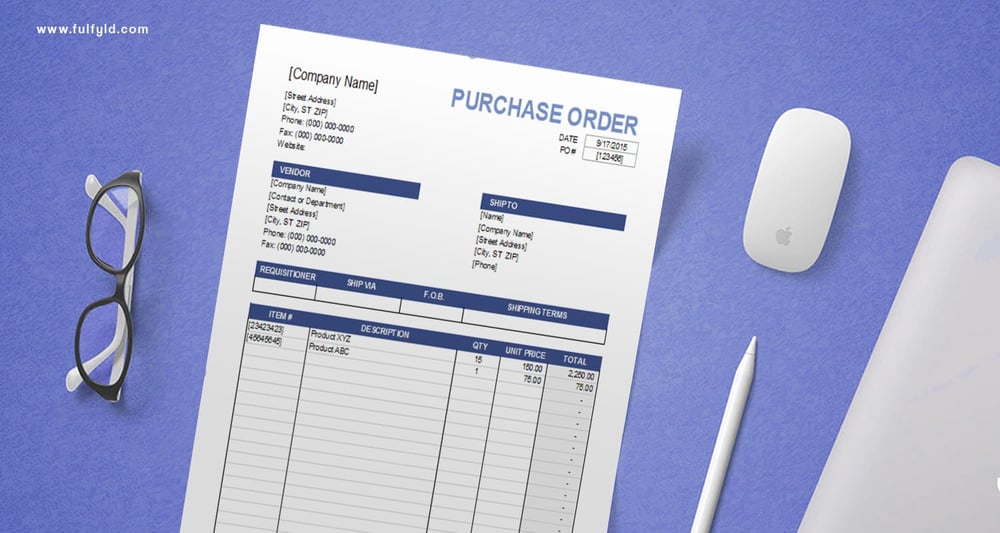Understanding Commercial Documents: Purchase Order, Invoice and Packing Slip

The purchasing process involves many papers, documents, and bills that one can easily get lost in the shuffle. It is important, as both buyers and sellers understand the purpose of these documents so purchases can run smoothly.
In this post, we will look at some of the most common commercial documents you might come across during the purchasing process:
- Purchase Order
- Invoice
- Packing Slips
Table of Contents
TogglePurchase Order
A purchase order will be the first major document in the purchasing process. It is an order issued by a buyer to a seller requesting the purchase of goods or services. The purchase order includes several crucial details like type of goods or services, quantity, price etc. In simple terms, a purchase order states what a buyer wants and how much to be included in the order. It also outlines the payment terms and purchase agreement between the two parties. Purchase orders have made it easier for businesses to track inventory and payments, making the purchasing process more efficient. It additionally allows businesses to keep a detailed record of all their transactions.
There are several steps involved in issuing a purchase order.
- Selecting the goods that need to be purchased and drafting the purchase order to send to the seller. The buyer identifies the product or service along with the quantity they need and creates a draft with this information. The draft also includes information such as the date of the order, FOB shipping information, discount terms, names of the buyer and seller, description of the goods being purchased, item number, price, quantity, and the PO number.
- Once the seller receives the purchase order draft, they will review the request and check their inventory for the availability of the required goods. The seller has the right to accept or reject the order. Upon acceptance, the authorized manager will sign off on the document, legally binding the two parties into an agreement.
- Once the purchase order has been placed and signed, the buyer will receive an approved copy of the order. At this stage, the PO becomes an open purchase order, signifying that the order is placed and delivery of the goods is pending.
When drafting a purchase order, it is important to include certain information and format the document correctly to ensure clear communication with the seller. It should have:
- Buyer and vendor information (company name, address, etc.)
- Order date and order number
- Shipping address – where the order should be delivered to
- Order details:
- requested items
- SKU number
- quantity required of each item
- unit price
- Shipping terms:
- F.O.B (Free on Board): indicates when liability and ownership of goods is transferred from a seller to a buyer. Under F.O.B. shipping point, the ownership of goods transfer to the buyer at the shipping point. Thus, the seller is not responsible for the goods during transit. Under F.O.B. destination however, the ownership of goods lies with the seller during transit and is transferred once it arrives at the buyer’s port.
- F.A.S (Free Alongside Ship): Under F.A.S. terms, the seller clears goods for export and places them alongside the vessel at the named port of departure. Here, the seller assumes responsibility for all expenses until freight is on the vessel, then the buyer takes over.
- C.I.F. (Cost, Insurance, and Freight): Under CIF terms, the seller is responsible for the expenses to cover the costs, insurance, and freight of a buyer’s order while it is in transit.
- C.P.T. (Carriage Paid To): The C.P.T. rule requires the seller delivers the goods at their expense to a carrier or another person nominated by the seller. The seller assumes all risks, including loss, until the goods are in the care of the nominated party.

Pictured above: Blank example of a Purchase Order.
For more purchase order templates you can visit the following sites:
Types of Purchase Orders
There are four distinct types of purchase orders based on how much information is included in them. They are:
- Standard Purchase Orders
This is the most common type of purchase orders. Standard POs clearly defines the details of the purchase. This can include outlining which item/service is being purchased, its quantity, delivery date and payment terms. - Planned Purchase Orders
A buyer places a planned purchase order based on the future needs of his business. In this case, a PO specifies details just like a standard purchase order. What is unique is that the quantity needed is an estimated guess and the delivery date can be tentative. - Blanket Purchase Orders
A blanket purchase order is placed when the buyer is looking to make multiple orders at once. It allows the buyers to negotiate a discounted price for the bulk purchase. - Contract Purchase OrderThis is the most formal type of purchase order. Here, the buyer and seller sign a legal contract summarizing the purchase details before any purchase order is issued. Contract POs provide
Invoice
An invoice is a commercial document that serves as a record of sale between two parties. It verifies the payment terms agreed between the buyer and seller and is non-negotiable. Simply put, an invoice is a seller asking the buyer to pay for the goods they purchased.
Invoices should indicate:
- Purchase order number
- Purchaser and Vendor information
- Items sold
- Shipment date
- Unit price
- Payment terms
- Tax deductions
- Discounts (if any)
- Additional details about the shipment.

Pictured above: Blank example of an Invoice.
You can find many free invoice templates online. Here are a few sites you can use:
The difference between a Purchase Order and an Invoice
The purchase order and invoice are two particularly important sales documents, but they should not be confused with each other, as they both serve different purposes. The purchase order is the request from a buyer to purchase goods or services from a business and it is issued before the invoice. An invoice is more like a reminder to make payment for the goods or services used, issued by the seller to the buyer. The purchase order puts forwards the terms for the purchase requested by the buyer. Once accepted by the seller, an invoice is issued confirming those terms. Thus, the invoice is the document that comes after the purchase order. All the technical details about the purchase that are included in a purchase order may not be found in an invoice. Rather, an invoice presents the summarized terms of the purchase.
Packing Slips
A packing slip is a document that contains the list of all items included in a package or shipment. They can also be known as a waybill, packing list or shipping list. This document breaks down product details into a list that helps the purchaser cross-check items in the shipment with what they ordered. It consists of all necessary information about the item like the weights, dimensions, number of cartons, its packing sizes, the total quantity of each product, etc. It may also contain additional information, such as the name and address of the recipient, the amount paid/due, extra charges, and a packing slip number.
In comparison to brick-and-mortar stores, eCommerce shopping come with a lot of unique steps and complications. Because the purchasing process all occurs online, packing slips help provide clarity and transparency to your customers. Many brands include packing slips with their orders for the following reasons:
- Ensures that the right items are being shipped
A packing slip is a record of all physical items in a package. Packing slips help sellers verify that they ship the correct items as per their customers’ orders. It provides sellers with an accurate count of the items being shipped. It can also be used as a check during the quality control phase of order fulfillment to minimize discrepancies and ensure that the right items in the right quantities are shipped out. - Identify lost or damaged goods
Packing slips serve as evidence of products Thus, in case of any accident during shipment, packing slips helps initiate the refund or product replacement process. - Helps customers verify the products
Once the package is delivered, the customer can crosscheck the items in the package with the help of the packing slip. It helps customers identify any problem with their package and notify the seller if an item has been damaged or wrongly delivered. - Smoothens the purchasing process
Highlighting all the points above, a packing slip simply makes it easier for buyers and sellers to complete the purchasing process without any hassles. With the packing slip, the seller ensures that the right products are dispatched, the shipment team can verify the package and the buyer can cross-check his order. Overall, it organizes the purchasing process and strengthens business relations between the buyers and sellers.
As previously established, packing slips are crucial when fulfilling eCommerce orders because they contain necessary information for each stakeholder in the transaction. There will be obvious differences in the exact details each packing slip holds but they all have homogeneity in their composition. All packing slips include important common labels like:
- Company Information
- Name
- Logo
- Contact Information
- Order number and date
- Recipient information
- Name
- Shipping address
- Billing address (if different from shipping address)
- Product Number (SKUs or UPCs)
- Product description
- Order quantity and Shipping Quantity
- Notes (if any)
Reach out to Fulfyld today and we can either help arrange your international shipment or provide you with a commercial packing list template to make your life easier!

Pictured above: Blank example of a Packing Slip.
The above example of a packing slip has all the necessary information required. You can always use packing slip templates and customize them to the needs of your business. You can use to following sites to find free packing slip templates:
How is a Packing Slip different from an Invoice?
There is often confusion between the similarity of packing slips and invoices, but they are not the same. The two slips serve different purposes entirely despite looking similar, which we will clarify in this section.
A packing slip is the list of physical goods purchased and shipped, whereas an invoice is the payment order for the purchase made. Packing slips are used to cross-check the items in the package with the purchase order and keep track of the items in case they are lost or damaged. An invoice is a document to make the customer aware of the payment needing to be completed for the goods they purchased.
A packing slip is important not just for the seller and buyer, but also for the shipment company to accurately keep track of the products they are carrying. An invoice, however, has no such relevance for the shipping company. It is sent directly to the customer as the shipping company is not interested in knowing the prices of the products. The packing slip is meant for the shipping company and the warehousing team to record the incoming goods. An invoice goes to the accounting department or the person responsible for making the payment.
It is also important to note that a packing slip is only required when the transaction involves the shipment of physical goods. Service-based businesses, thus, do not need to issue packing slips. However, all businesses must issue invoices as it is a record of the financial transaction.
Each of these documents are essential in ensuring smooth transition of good from seller to buyer. Here at Fulfyld, we offer packing slips into each order, with logo customization and provisions for unique fields as per your business’s needs. Contact us now for more information!